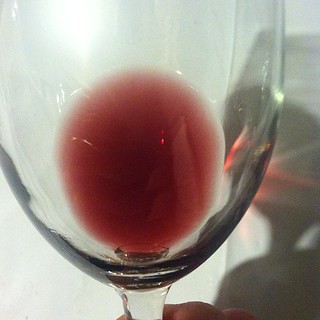You’re really supposed to wait six months after bottling a red wine before you taste it…but I couldn’t resist!
When I bottled my Shiraz I wound up with 29 full bottles and about a half bottle left over. Needless to say I couldn’t store the half bottle for any length of time without oxidizing it. So, the only thing left to do was drink it!
I wanted to taste the wine as bottled for two reasons. First, I wanted to know what it tastes like in the beginning so that I have something to compare it to as it ages. Second, I wanted to see if I made any mistakes that I could learn from. Here’s what I found when I tasted my wine.
It’s Definitely a Young Wine
I had never tasted a wine quite this young before and wasn’t sure what to expect. However, after only a few sips it became evident that this was indeed a young wine.
For starters the tannins are a bit gritty. They haven’t had time to string together and form longer molecules. Longer tannin molecules are much smoother than what I was experiencing.
Additionally there was a distinct green taste to the wine. Almost as if I’d bitten into a grape stem. This will go away as the wine matures.
Looking at it in the glass it has a color to it. Most young wines have a purple tint to them that eventually fades to red. The fact that mine is red really doesn’t tell me much being that it’s from a kit. I think the color would be more telling had I used fresh grapes. However, the fact that it’s not brown or orange tells me the wine is basically in good shape.
My Mistakes
Despite the lack of aging there were three mistakes that became self-evident in my half bottle of wine. While it is very disappointing to find so many mistakes this is how a winemaker learns and grows.
1. I didn’t get all of the carbon dioxide out during degassing.
After twenty minutes with the wine whip I thought I’d gotten all of the carbon dioxide out. However, upon tasting the final product I could clearly detect some bubbles on my tongue.
Just to make sure I wasn’t mistaking high acidity for bubbles I gave a sample of wine a shake in my test jar and was greeted with a burst of carbon dioxide when I removed my hand. Proof that there is still gas suspended in there.
Next time I need to be much more patient and diligent with the degassing tools. Also, had I kept the wine at the proper temperature during fermentation and clarification I wouldn’t have had so much trouble getting the carbon dioxide out.
2. There is sediment in my bottled wine.
During bottling there were a couple of times when I started to lose my siphon. In an act of desperation I plunged the racking cane to the bottom of the carboy so that it would stop taking in air. By doing this I wound up sucking up some of the lees.
Because Shiraz is so dark you really can’t see that there is suspended sediment when it’s in something as large as a carboy. The sediment becomes clearly visible once it has been poured though.
3. The wine is a little watery.
The grape juice concentrate that comes with the kit is re-hydrated with water prior to fermenting. After fermentation is complete you are supposed to top off the carboy with water to a specified level.
While I was only following the directions for topping up it did make my wine too thin. The directions have been revised and no longer call for topping up with water.
Winexpert has determined that kit wines, if made according to their schedule, are not in the carboys long enough to oxidize so topping up to reduce the amount of oxygen in the carboy is unnecessary.
Moving Forward
While I am disappointed in myself and my Shiraz I will keep it and see how it ages over time. I’ve learned some valuable lessons here that I’m glad to pass on to you in the hopes that you don’t repeat my mistakes.
I’m preparing to buy my second kit and have a clear idea of what I need to do to prevent these mistakes in my next wine. I’ll be sharing more on my mistakes and how to avoid them in the very near future.


One Reply to “First Impressions of My Shiraz and the Mistakes I Made”
Comments are closed.